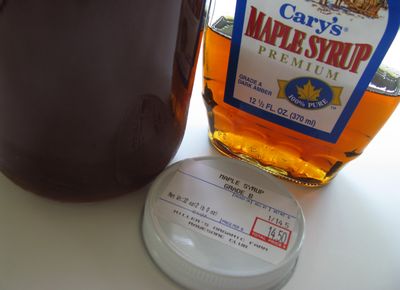I was on a quest recently to discover the difference between Grade A and Grade B maple syrup, so I purchased a quart of Grade B maple syrup from an Amish farmer in Pennsylvania to compare it with a bottle of Grade A maple syrup. In a nutshell, Grade A is the first syrup of the season and is lighter in color with a delicate, milder flavor. Grade B comes from batches at the end of the season and is darker in color with a more pronounced maple flavor.
In simplistic terms, what is the science behind this? As the sap season progresses and the trees get closer to leafing out, there is less sugar content in the sap. Therefore, it needs to be boiled longer to evaporate the water from the sap to achieve the thickness that characterizes syrup. This not only makes it thicker, but it also gives it a darker appearance. Maple syrup is sold in four grades: Grade A Light Amber, Grade A Medium Amber, Grade A Dark Amber, and Grade B. (There is a fifth grade called Grade C Commercial that is sold in 40 gallon barrels to industrial producers of maple flavored products.)
For a beautifully photographed free printable depicting how to collect sap from maple trees and transform it into syrup, along with a delightful blog post that chronicles the process, head over here. After reading the blog's posts, you'll want to slip on a pair of snow boots and find the nearest maple tree to tap. (The trees suitable for tapping include all of the maple family: sugar, silver and red maples as well as box elder. Sugar maple sap contains the highest concentration of sugar.)
So what do I think of Grade B maple syrup now that I have spoon-tested it, slurping one spoonful, then another, and another, and another… with a little drizzle that made its way on top of pancakes? Will I avoid it as I did in the past because I mistakenly believed that the "lower" Grade B rating was an indication of it insuperiority? Definitely not! Will I go out of my way to unearth a local source? Definitely!





Leave a comment